
Krefeld, also spelled Crefeld until 1925, is a city in North Rhine-Westphalia, Germany. It is located northwest of Düsseldorf, its center lying just a few kilometers to the west of the river Rhine; the borough of Uerdingen is situated directly on the Rhine. Because of its economic past, Krefeld is often referred to as the "Velvet and Silk City". It is accessed by the autobahns A57 (Cologne–Nijmegen) and A44 (Aachen–Düsseldorf–Dortmund–Kassel).
Viersen is a Kreis (district) in the west of North Rhine-Westphalia, Germany. Neighboring districts are Cleves, Wesel, district-free Krefeld, Neuss, district-free Mönchengladbach, Heinsberg and the Dutch province of Limburg.

Wesel is a Kreis (district) in the northwestern part of North Rhine-Westphalia, Germany. Neighboring districts are Borken, Recklinghausen, district-free cities Bottrop, Oberhausen, Duisburg and Krefeld, districts Viersen, Cleves.
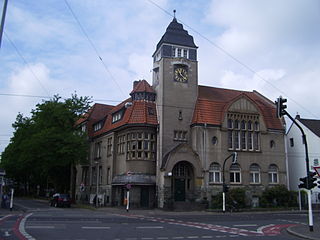
Fischeln is the most southerly district of Krefeld, Germany. Its population is 26,030 (2019) and its area is 18.99 km2 (7.33 sq mi). Older than Krefeld, Fischeln was first mentioned as "Viscolo" around 900AD. Fischeln became a district of Krefeld in 1929.

Roer was a department of the French First Republic and later First French Empire in present-day Germany and the Netherlands. It was named after the river Roer (Rur), which flows through the department. It was formed in 1797, when the left bank of the Rhine was occupied by the French. The department was formed from the duchies of Jülich and Cleves, the part of the Archbishopric of Cologne left of the Rhine, the Free City of Aachen, the Prussian part of the duchy of Guelders and some smaller territories. In 1805 the city of Wesel was added to the department. The capital was Aix-la-Chapelle (Aachen).
Forstwald is a quarter (Stadtteil) of Krefeld, western Germany, located to the west of the main city center. It is marked by its forest landscape and more up-scale housing than other regions of Krefeld. Its population is 3,545 (2019) and its area is 4.12 km2 (1.59 sq mi).

The Grotenburg-Stadion is a multi-use stadium in Krefeld, Germany. It is used mostly for football matches and hosts the home matches of KFC Uerdingen 05. The stadium has a capacity of 34,500 and was built in 1927.

Yayla Arena, formerly known as KönigPALAST from 2004 to 2018, is an arena in Krefeld, Germany. It is primarily used for ice hockey, and is the Home to the Krefeld Pinguine. It opened in 2004 and holds 8,029 people. The original name sponsor was the König Brewery from Duisburg.
There are several lakes named Mud Lake within the U.S. state of Iowa.
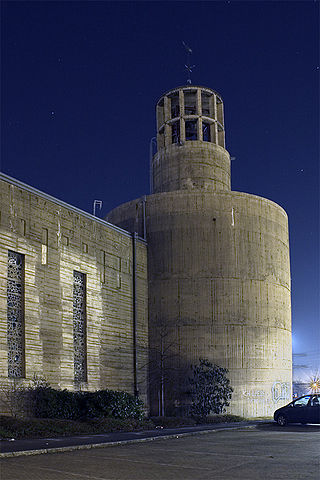
Heerdt is one of the older quarters of the city of Düsseldorf, part of Borough 4. Heerdt and its neighbouring quarters Oberkassel, Niederkassel and Lörick lie on the left side of the river Rhine, opposite to the other districts of Düsseldorf and the central district. Heerdt has an area of 4.05 km2 (1.56 sq mi), and 12,395 inhabitants (2020).

The Lower Rhine region or Niederrhein is a region around the Lower Rhine section of the river Rhine in North Rhine-Westphalia, Germany, between approximately Oberhausen and Krefeld in the East and the Dutch border around Kleve in the West. As the region can be defined either geographically, linguistically, culturally, or by political, economic and traffic relations throughout the centuries, as well as by more recent political subdivisions, its precise borders are disputable and occasionally may be seen as extending beyond the Dutch border.

Uerdingen is a district of the city of Krefeld, Germany, with a population of 17,888 (2019). Originally a separate city in its own right, Uerdingen merged with the city of Krefeld in 1929. Today, Uerdingen is best known for a local distillery and a railcar factory, and is the eponym of the Uerdingen line.
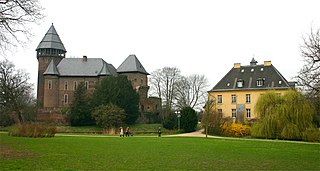
Linn has been a part of the city of Krefeld, Germany, since its incorporation into that city in 1901. Linn lies with its historic city center within the lower Rhenish lowlands about 5 km (3.1 mi) east of the Krefeld city center. Krefeld-Linn station is served by the Rhein-Niers-Bahn and the Emscher-Niederrhein-Bahn Regionalbahn services.

The Temecula Valley is a graben rift valley in western Riverside County, California.

Krefeld Hauptbahnhof is the largest station of the city of Krefeld in the German state of North Rhine-Westphalia. The double-track and electrified Duisburg-Ruhrort–Mönchengladbach railway and the Lower Left Rhine Railway cross at the station.
Paaste is a village in Saaremaa Parish, Saare County in western Estonia.

The Duisburg-Ruhrort–Mönchengladbach railway is a historically significant, but now partly abandoned line in the German state of North Rhine-Westphalia. The line was built by the Ruhrort-Crefeld District Gladbach Railway Company, founded in 1847, and is one of the oldest lines in Germany, opened in 1849 and 1851.
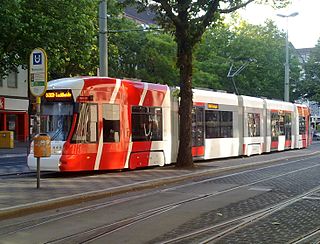
The Krefeld tramway network is a network of tramways forming part of the public transport system in Krefeld, a city in the federal state of North Rhine-Westphalia, Germany. Opened in 1883, the network has been operated since 2002 by SWK MOBIL, and is integrated in the Verkehrsverbund Rhein-Ruhr (VRR).
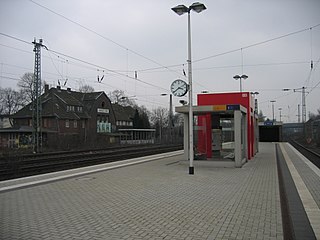
Krefeld-Linn station is a regional station in the district of Linn in the city of Krefeld in the German state of North Rhine-Westphalia. It lies on the Osterath–Essen railway; the Rhenish Railway Company gained a concession to build the line on 16 July 1863. The line was opened on 1 September 1866, with the stations not yet finished. Linn station was opened on 15 October 1874 and the first entrance building was also put into operation at this time. The station name was changed to Crefeld-Linn in 1905 and Krefeld-Linn in 1925. This name still applies today.
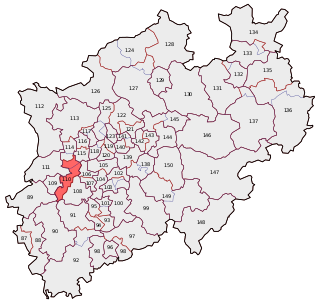
Krefeld I – Neuss II is an electoral constituency represented in the Bundestag. It elects one member via first-past-the-post voting. Under the current constituency numbering system, it is designated as constituency 110. It is located in western North Rhine-Westphalia, comprising the southern part of the city of Krefeld and the northern part of the Rhein-Kreis Neuss district.















